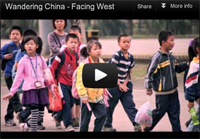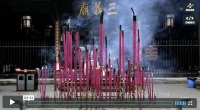Foreign Policy: associate editor Isaac Fish on China’s monolithic ‘model of endless fractal Beijings’. One one hand, this penchance for megalopolises seem to be emblems for party legitimacy, one couched in projecting national identity at the expense of social utility.
A compelling read especially since Fish has physically been to 21 of 22 provinces and all of the Autonomous Regions. This overarching proposition echoes China’s vice minister of construction Qiu Baoxing who lamented in 2007, “It’s like a thousand cities having the same appearance.”
Perhaps this identifies the trapping of the model of Chinese characteristics.
Three decades of supercharged catching up after a century of humiliation. The twentieth century it spent trying to find an ideological fit amidst civil war, and then reform and systemically imposed ideological homogeneity. But all along, hung the spectre of 5,000 years of leftover memories of the grandiose, ones that perhaps the everyday Chinese too cling onto – and it is this image state media is constantly churning, through cultural capital in its well-funded tv programmes and film – one it recognises as a pillar industry in its current five-year plan.
And… massive building projects have always been a hallmark of the Chinese dynasties rising in power back through antiquity. Today they will keep doing the same, and they expanded on this to help others do likewise. Their building of parliamentary buildings and sports stadiums as part of foreign aid to African nations in exchange for keys for access to their natural resources as an example.
On the other hand – outside the penchance for the grandiose, it was only until recently that images that represented China bore the individual’s narrative. The advert that ran in Times Square in 2011 is a case in point. The messages the American audience derived from that however, is another long discussion.
So for a long time, the messages sent to both domestic and foreign audience were of largely based on Chinese symbolism – from its inventions, scholarship and , to the Great Wall and Forbidden Palace.
Also consider what’s left factoring in the knowledge lost through the books burnt and cultural artefacts destroyed or misplaced through dynastic attempts at centralisation and the prior communist model. So, what they are left with are remnant, selected works that continue to exist in the mainstream as they had utilitarian purpose in organising the state in its affairs of governance and framework for high culture.
All that said, one only has to tune into Chinese television programmes to see that with their great cities, the Chinese people are becoming increasingly conversant, cognizant of the ways of the world. The difference is the discourse seldom exists outside the overriding system of stability as fewer and fewer want to give up the economic benefits they are reaping. They have, like many developed populaces, participants in the progress trap.
So the proposition that Fish poses at the end of his article is pertinent. How will the Chinese, and the party that leads them figure out how to work together to make all this come to equitable fruition, and thus magnificent?
– – –
Unliveable Cities
China’s megalopolises may seem impressive on paper, but they are awful places to live.
by Isaac Stone Fish
Source – Foreign Policy Magazine, published August 13, 2012

Source – Foreign Policy
In Invisible Cities, the novel by the great Italian writer Italo Calvino, Marco Polo dazzles the emperor of China, Kublai Khan, with 55 stories of cities he has visited, places where “the buildings have spiral staircases encrusted with spiral seashells,” a city of “zigzag” where the inhabitants “are spared the boredom of following the same streets every day,” and another with the option to “sleep, make tools, cook, accumulate gold, disrobe, reign, sell, question oracles.” The trick, it turns out, is that Polo’s Venice is so richly textured and dense that all his stories are about just one city.
A modern European ruler listening to a visitor from China describe the country’s fabled rise would be better served with the opposite approach: As the traveler exits a train station, a woman hawks instant noodles and packaged chicken feet from a dingy metal cart, in front of concrete steps emptying out into a square flanked by ramshackle hotels and massed with peasants sitting on artificial cobblestones and chewing watermelon seeds. The air smells of coal. Then the buildings appear: Boxlike structures, so gray as to appear colorless, line the road. If the city is poor, the Bank of China tower will be made with hideous blue glass; if it’s wealthy, our traveler will marvel at monstrous prestige projects of glass and copper. The station bisects Shanghai Road or Peace Avenue, which then leads to Yat-sen Street, named for the Republic of China’s first president, eventually intersecting with Ancient Building Avenue. Our traveler does not know whether he is in Changsha, Xiamen, or Hefei — he is in the city Calvino describes as so unremarkable that “only the name of the airport changes.” Or, as China’s vice minister of construction, Qiu Baoxing, lamented in 2007, “It’s like a thousand cities having the same appearance.”
Why are Chinese cities so monolithic? The answer lies in the country’s fractured history. In the 1930s, China was a failed state: Warlords controlled large swaths of territory, and the Japanese had colonized the northeast. Shanghai was a foreign pleasure den, but life expectancy hovered around 30. Tibetans, Uighurs, and other minorities largely governed themselves. When Mao Zedong unified China in 1949, much of the country was in ruins, and his Communist Party rebuilt it under a unifying theme. Besides promulgating a single language and national laws, they subscribed to the Soviet idea of what a city should be like: wide boulevards, oppressively squat, functional buildings, dormitory-style housing. Cities weren’t conceived of as places to live, but as building blocks needed to build a strong and prosperous nation; in other words, they were constructed for the benefit of the party and the country, not the people. Read the rest of this entry »
Filed under: Beijing Consensus, Charm Offensive, Chinese Model, Collectivism, Corruption, Culture, Domestic Growth, Economics, Environment, Foreign Policy Magazine, Government & Policy, Influence, Infrastructure, Mapping Feelings, Nationalism, New Leadership, Peaceful Development, People, Politics, Pollution, Population, Poverty, Property, Resources, Social, Soft Power, The Chinese Identity, The construction of Chinese and Non-Chinese identities, China's Rise, culture, Economics, Education, Environment, Natural Resources, Politics, Public Diplomacy















The Sharing Circle